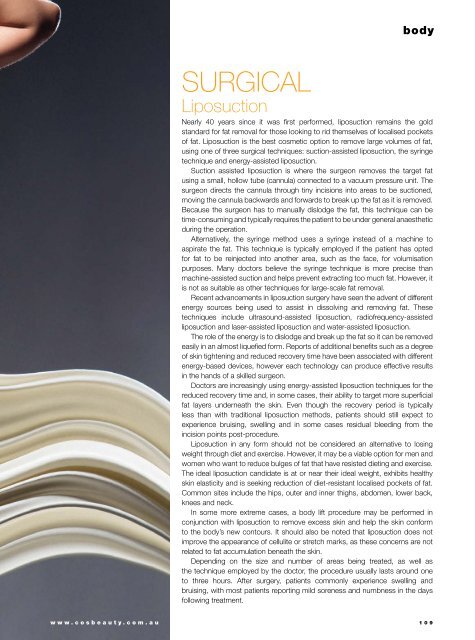Cosmetic Surgery and Beauty Magazine #66
Cosmetic Surgery and Beauty is the must-read for anyone considering a cosmetic procedure or treatment. With hundreds of before and after photo, and cosmetic and plastic surgery experts featured, tis educational resource will allow you to confidently decide the best course of action. This issue includes features on: Breast reshaping Six ways to get younger looking skin Surgical vs non-surgical fat reduction Body soothing products Energy boosters DIY perfect makeup As well as regular features on breast augmentation, facelifting, rhinoplasty and liposculpture/liposuction.
Cosmetic Surgery and Beauty is the must-read for anyone considering a cosmetic procedure or treatment. With hundreds of before and after photo, and cosmetic and plastic surgery experts featured, tis educational resource will allow you to confidently decide the best course of action.
This issue includes features on:
Breast reshaping
Six ways to get younger looking skin
Surgical vs non-surgical fat reduction
Body soothing products
Energy boosters
DIY perfect makeup
As well as regular features on breast augmentation, facelifting, rhinoplasty and liposculpture/liposuction.
You also want an ePaper? Increase the reach of your titles
YUMPU automatically turns print PDFs into web optimized ePapers that Google loves.
ody<br />
Surgical<br />
Liposuction<br />
Nearly 40 years since it was first performed, liposuction remains the gold<br />
st<strong>and</strong>ard for fat removal for those looking to rid themselves of localised pockets<br />
of fat. Liposuction is the best cosmetic option to remove large volumes of fat,<br />
using one of three surgical techniques: suction-assisted liposuction, the syringe<br />
technique <strong>and</strong> energy-assisted liposuction.<br />
Suction assisted liposuction is where the surgeon removes the target fat<br />
using a small, hollow tube (cannula) connected to a vacuum pressure unit. The<br />
surgeon directs the cannula through tiny incisions into areas to be suctioned,<br />
moving the cannula backwards <strong>and</strong> forwards to break up the fat as it is removed.<br />
Because the surgeon has to manually dislodge the fat, this technique can be<br />
time-consuming <strong>and</strong> typically requires the patient to be under general anaesthetic<br />
during the operation.<br />
Alternatively, the syringe method uses a syringe instead of a machine to<br />
aspirate the fat. This technique is typically employed if the patient has opted<br />
for fat to be reinjected into another area, such as the face, for volumisation<br />
purposes. Many doctors believe the syringe technique is more precise than<br />
machine-assisted suction <strong>and</strong> helps prevent extracting too much fat. However, it<br />
is not as suitable as other techniques for large-scale fat removal.<br />
Recent advancements in liposuction surgery have seen the advent of different<br />
energy sources being used to assist in dissolving <strong>and</strong> removing fat. These<br />
techniques include ultrasound-assisted liposuction, radiofrequency-assisted<br />
liposuction <strong>and</strong> laser-assisted liposuction <strong>and</strong> water-assisted liposuction.<br />
The role of the energy is to dislodge <strong>and</strong> break up the fat so it can be removed<br />
easily in an almost liquefied form. Reports of additional benefits such as a degree<br />
of skin tightening <strong>and</strong> reduced recovery time have been associated with different<br />
energy-based devices, however each technology can produce effective results<br />
in the h<strong>and</strong>s of a skilled surgeon.<br />
Doctors are increasingly using energy-assisted liposuction techniques for the<br />
reduced recovery time <strong>and</strong>, in some cases, their ability to target more superficial<br />
fat layers underneath the skin. Even though the recovery period is typically<br />
less than with traditional liposuction methods, patients should still expect to<br />
experience bruising, swelling <strong>and</strong> in some cases residual bleeding from the<br />
incision points post-procedure.<br />
Liposuction in any form should not be considered an alternative to losing<br />
weight through diet <strong>and</strong> exercise. However, it may be a viable option for men <strong>and</strong><br />
women who want to reduce bulges of fat that have resisted dieting <strong>and</strong> exercise.<br />
The ideal liposuction c<strong>and</strong>idate is at or near their ideal weight, exhibits healthy<br />
skin elasticity <strong>and</strong> is seeking reduction of diet-resistant localised pockets of fat.<br />
Common sites include the hips, outer <strong>and</strong> inner thighs, abdomen, lower back,<br />
knees <strong>and</strong> neck.<br />
In some more extreme cases, a body lift procedure may be performed in<br />
conjunction with liposuction to remove excess skin <strong>and</strong> help the skin conform<br />
to the body’s new contours. It should also be noted that liposuction does not<br />
improve the appearance of cellulite or stretch marks, as these concerns are not<br />
related to fat accumulation beneath the skin.<br />
Depending on the size <strong>and</strong> number of areas being treated, as well as<br />
the technique employed by the doctor, the procedure usually lasts around one<br />
to three hours. After surgery, patients commonly experience swelling <strong>and</strong><br />
bruising, with most patients reporting mild soreness <strong>and</strong> numbness in the days<br />
following treatment.<br />
www.cosbeauty.com.au 109

















